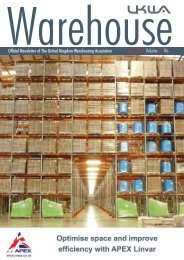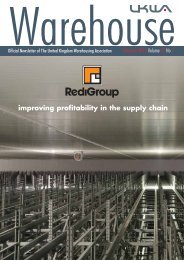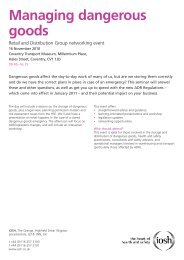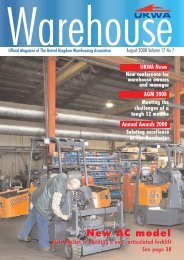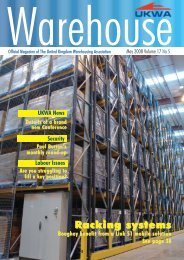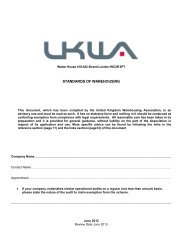ifwla - Warehousing and Logistics International
ifwla - Warehousing and Logistics International
ifwla - Warehousing and Logistics International
- No tags were found...
Create successful ePaper yourself
Turn your PDF publications into a flip-book with our unique Google optimized e-Paper software.
36 North AmericaABOVE:A shipin dock atPort MetroVancouvermanufacturing country by shiftingmanufacturing inl<strong>and</strong>, making hugetransportation infrastructure investments<strong>and</strong> maintaining beneficial tax<strong>and</strong> exchange rate policies. However,the long run trend in every competitivefactor indicates that manufacturingcosts will increase faster in Chinathan in competing low cost countries.This is compounded by the trend towards dem<strong>and</strong> drivensupply chains that seek to postpone the final processingof the product until dem<strong>and</strong> is known with certainty.Mexico is the ideal compromise of low cost <strong>and</strong>proximity to the U.S. market allowing responsiveness todem<strong>and</strong> changes. Near sourcing from Mexico willincrease <strong>and</strong> other Asian countries will grab exportshare. Products manufactured in Mexico will movedirectly by l<strong>and</strong> while products exported from India aremore likely to be transported to eastern <strong>and</strong> centralU.S. markets via East Coast ports. This will reduce theshare of inbound containers via the West Coast <strong>and</strong> thesize of the market for which PMV is competitive .Some of these factors are also impacting the destinationof imported goods in North America. For examplewage rates have shifted manufacturing growth fromnorth central <strong>and</strong> east coast location to south central<strong>and</strong> southwest locations <strong>and</strong> the population has followedas noted above.Potential Competitive ScenariosBased on likely directions in the factors identifiedabove, the following competitive environments <strong>and</strong>scenarios are posited for PMV over the near, medium<strong>and</strong> long run. In all of these scenarios, PMV continuesto be the dominate gateway for imports from Asia destineto Canada.2010 to 2015• The world has recovered from the recession. Chinacontinues to be the main source of imports to NorthAmerica <strong>and</strong> resumes its high growth in exports to N.A.• China has maintained it competitive advantage as alow cost manufacturing center by shifting some of itsproduction to inl<strong>and</strong> China where wage costs are lower<strong>and</strong> connecting those locations to the coastal ports withhuge infrastructure improvements.• Much of the import traffic growth is to the centralU.S. with gradual shifting of economic activity furthersouth.• PMV effectively competes with Seattle – Tacoma <strong>and</strong>LA-LB for this traffic due to the reliable service reputationthat it has earned.• The reliable service was achieved through jointimprovement processes between the gateway/corridorstakeholders, joint (public-private) infrastructureimprovements funded through the APGC program <strong>and</strong>an innovative industrial relations environment affectinglabor from port to final destination.• U.S. gateway competitors make substantial infrastructureimprovements but institutional barriers preventcomparable levels of cooperation in competing U.S.gateways <strong>and</strong> corridors.• PMV captures larger share of growing traffic basefrom North Asia to central <strong>and</strong> south central U.S.2016 – 2030• China maintains its low cost country status butgrowth in exports to North America begins to slow.• Portion of historically high growth of exports to N.A.lost to countries in Southeast <strong>and</strong> South Asia whereIssue No. 3www.warehousinglogisticsinternational.com






